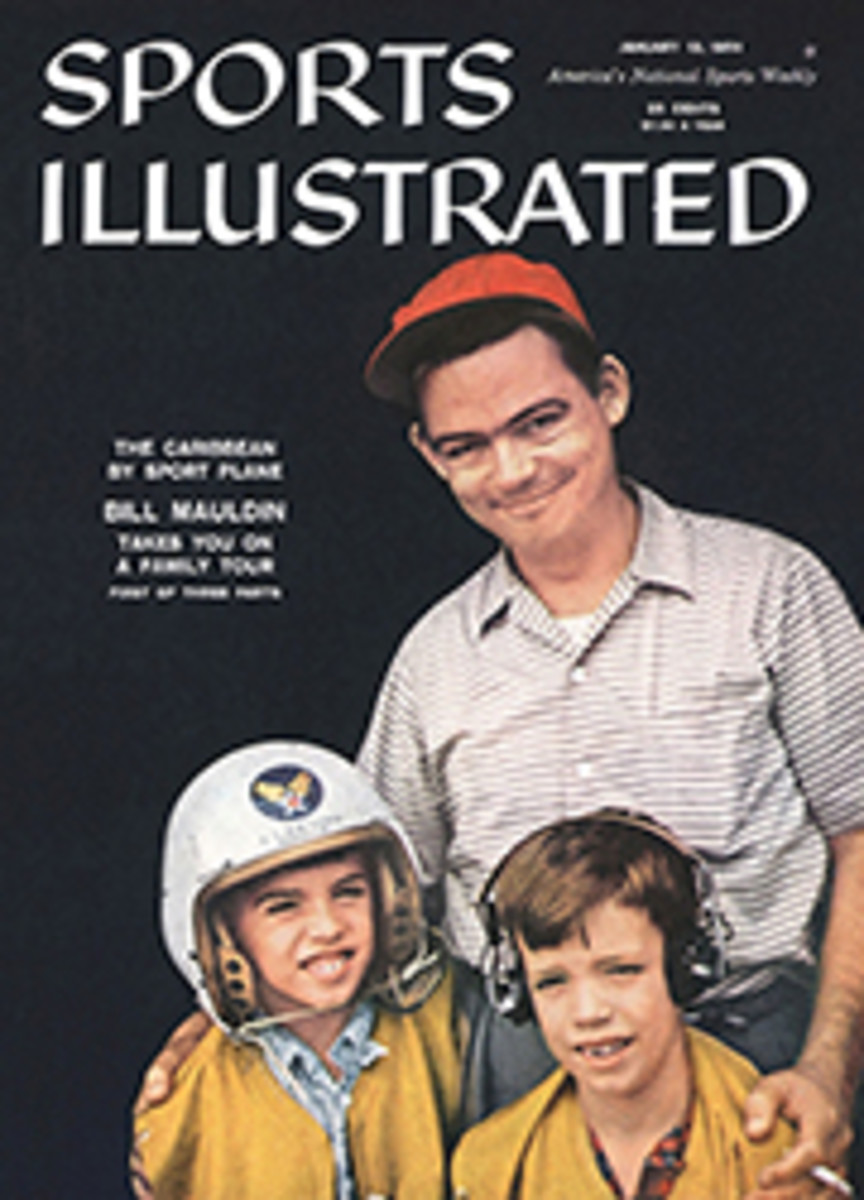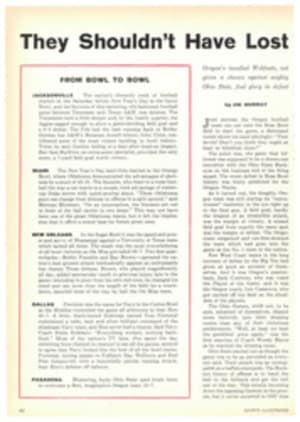
ANOTHER OPENING, ANOTHER SHOW
Last week, the holidays behind them and 5,000 miles of pressureful golf ahead, America's most colorful itinerant community, the professional circuit golfers, congregated at the Rancho golf course for the 32nd Los Angeles Open, the tournament which traditionally inaugurates the winter tour and, so to speak, puts the show on the road again. Frank Stranahan won the premi√®re with a 275 for his biggest pro victory to date. This week the Crosby (see page 28) and then, on 11 successive weeks, Tijuana, Palm Springs, Phoenix, Tucson, San Antonio, Houston, Baton Rouge, New Orleans, Pensacola, St. Petersburg, and, most likely, Wilmington—by and large, the familiar road that leads to Augusta and spring.
En route, as on earlier treks, the familiar pattern will unwind: the golfers who catch fire will be asked from city to city to explain just what accounts for their success, and no one will quite be satisfied when they answer, "I'm just thinking better out there" or "I'm just getting a few putts for a change—that's all." In February the stars who chose to winter on the Caribbean circuit (Panama, Jamaica, Puerto Rico) will rejoin the domestic division. The older hands, such as Jimmy Demaret (who was runner-up to Sam Houston for the Texas Boys Championship in 1821), will look no older, play as well as ever and will leave the tour after Houston or New Orleans and let the younger men have Florida to themselves. After the early tourneys, Charley Sifford, that good golfer who won the recent Long Beach Open, will leave the tour, picking it up later when it hits states in which it makes no difference if an entrant is colored or not. By the time the Florida segment of the arc is reached, a few new stars whose names nobody knows now will be laying in new supplies of hip haberdashery, but the roads north will be dotted with dozens of other young men who won no money, ran out of their own and could only wait till next year.
This year, as usual, the professionals will be shooting at a new record total of prize money and, as usual, a great many attendant financial and scheduling problems remain to be thrashed out. At the moment, for example, it is still not known for certain whether or not the last tournament in March will be held in Wilmington, N.C. For the past eight years this date was a Wilmington fixture, the Azalea Open, but the purse came only to $12,500, comparatively light by modern PGA standards. The PGA Tournament Bureau, accordingly, asked the Wilmington sponsors to see if they could up the prize money, explaining that an increase was essential since some 200 golfers depended on the tour for a living in an age of rising expenses. There are several accounts of the actual order and tone of the communications (or lack of communication) between the PGA representatives and the Wilmington group, but, suffice it to say, the PGA announced last autumn that Wilmington had lost its old spot and would be replaced by a $22,500 affair in Miami Beach. Only a short while ago, however, the projected Miami Beach tournament fell through. At this point, the PGA bureau head suggested to the Wilmington group that they sponsor a two-day $10,000 event on the Saturday and Sunday of that last week in March, a regular four-day event now being out of the question since a pro-amateur event had been booked for the Wednesday of that week in Miami Beach—and who, even what pro, can drive 900 miles overnight? The Wilmington group returned a counterproposal: they would be happy, they said, to provide a purse of $15,000 to underwrite a three-day 72-hole tournament this March, but would like a three-year contract insuring a regular place on the PGA schedule for a regular four-day tournament. At last report, this is where matters stood.
All of the elements of the typical PGA-sponsor hassle are present in this Wilmington case, and it would take a very wise head indeed to decide such inherent questions as these: Are the touring pros justified in thinking the purses must be high enough to give 200 members of the tour the wherewithal to keep going? Granted that replacing truly soft spots on the schedule with richer tournaments is a splendid thing, will it be injurious in the long run to make it almost a policy to sell tournament dates to the highest bidder (who may leave off sponsoring golf as quickly as he began it, once he has collected his fill of publicity); to drop old friends of golf like the Wilmington group and Elmer Ward, the veteran sponsor of 16 Palm Beach round-robin tourneys, because they do not meet the big-prize-money, 72-hole medal-play formula? On the other hand, it must be borne in mind that only a dozen or so of the touring pros make money or break even on the circuit. Since nearly everyone else profits rather handsomely from the attraction they provide, one can be sympathetic to their aims if not exactly enamoured with how they sometimes go about attaining them.
Familiar indeed, this wrangling, and so are the countless other aspects of the singular civilization that springs up as the nomads wend their way from oasis to oasis. Two pros, for instance, will begin to putt phenomenally with some new model blade, and within a week practically the entire cast will be out seeing if this model is the magic carpet-sweeper every man dreams of finding. Three young pros will use their first winnings to buy white cashmere jackets. Seven fairly veteran pros who have never been in the top 20 will agree that if they win the Tam O'Shanter they will turn down the extra $50,000 in exhibitions—it would take the competitive edge off their games. And, with very few exceptions, all the players, even though each realizes that the tour is necessarily a dog-eat-dog affair in which everybody else's brilliant streaks diminish his own chances for gain and glory, will show more genuine consideration toward their rivals than most amateurs do. Their uncomplicated sportsmanship under such rough conditions will impress the thoughtful members of the gallery quite as much as their ability to get down in two from 130 yards out, from sand traps, from the parking lot, from the soft drink stand, from anywhere.
KEEP YOUR EYE ON...
KEN VENTURI
Rated by many close to the scene as the best player currently on the circuit, Venturi, 26, is a protégé of Byron Nelson's and has inherited Nelson's wonderful sense of clubhead timing in his iron play. On the greens he once tended to be skiddish with his putting, but is tapping the ball very well these days. His victories at St. Paul and Milwaukee late last summer, his first season on the pro circuit, marked the only time since 1955 that any player has won two straight PGA co-sponsored events.
ARNOLD PALMER
The 28-year-old Palmer is a terribly strong and muscular player and another of golf's long hitters. The son of a Latrobe, Pa. club professional, he turned pro shortly after winning the National Amateur in 1954. Though still prone to erratic rounds, he has steadied down considerably without losing his flair for making as many spectacular shots as anyone on the tour. Streaky putting accounts for some of his ups and downs. His closest friends on the circuit are Doug Ford and Dow Finsterwald.
DOW FINSTERWALD
One of the great new students of the game and a fine technician, this quiet man from Ohio won the 1957 Vardon Trophy with a 70.30 strokes-per-round average in his third touring season. Finsterwald, 28, has a consistent, systematic approach to golf, trying to make each shot, each round, just as safe and easy as possible. He will always take straightness over distance and is extremely reluctant to release his reserve. Like a tennis player, Dow strives to maintain good stroke production at all times.
BILLY CASPER
A 26-year-old Navy veteran, Casper is one of the tour's most puzzling golfers. At first glance, he has none of the finish and form that characterize the play of a real top-notcher. Instead, he takes a vicious slash at the ball. However, he has great hand action, a real instinct for shotmaking, and is capable of great accuracy. He can go off on tremendous bursts of par-breaking golf. Casper was one of the surprises of 1957, his third year on the tour, has a stable temperament and is a really tremendous putter.
GEORGE BAYER
The longest hitter the game has ever known, and currently one of its biggest players at 6 foot 5 and 240 pounds, Bayer, 32, is a fine athlete, once played tackle for the Washington Redskins and is the possessor of a lovely golf swing. After four years on the tour, he has finally developed a well-rounded game and a fine putting touch for a man of his physique. If a bit immature temperamentally, Bayer, nonetheless, has a pleasant, boyish manner, which makes it that much more enjoyable to watch him.
PAUL HARNEY
Weighing only 145 pounds though 5 foot 11, this former Holy Cross golf captain and 1952 Eastern Collegiate champion has emerged as one of golf's longest hitters. Last year, his third as a touring professional, he began cutting down on the undue amount of body action he employed and vastly increased his accuracy. Harney, 28, is a steady iron player, mild and relaxed on the course. He enjoyed such a good year in 1957 that his fellow tourists voted him the most improved golfer on the circuit.
PHOTO
PHIL BATH
HERE, AGAINST A TYPICALLY CALIFORNIA BACKGROUND, A LIGHTLY CLAD GALLERY LABORS UP RANCHO'S 16TH FAIRWAY WITH AN OPENING-DAY THREESOME AT L.A. OPEN
SIX PHOTOS

